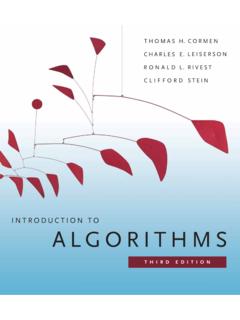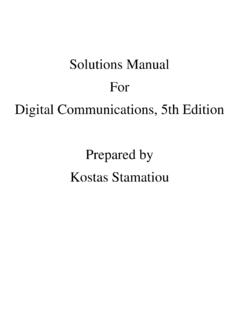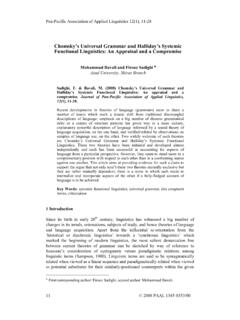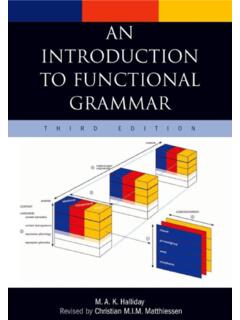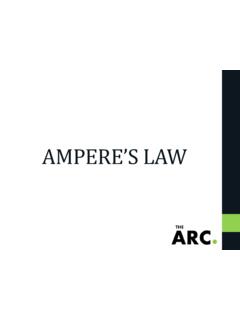Transcription of Instructor’s Solution Manual for Fundamentals of Physics ...
1 Instructor s Solution ManualforFundamentals of Physics , 6/Eby halliday , Resnick, and WalkerJames B. WhitentonSouthern Polytechnic State UniversityiiPrefaceThis booklet includes the solutions relevant to the EXERCISES & PROBLEMS sections of the 6theditionofFundamentals of Physics , by halliday , Resnick, and Walker. We also include solutions to problems inthe Problems Supplement. We have not included solutions or discussions which pertain to the am very grateful for helpful input from J. Richard Christman, Meighan Dillon, Barbara Moore, and JearlWalker regarding the development of this 11. The metric prefixes (micro, pico, nano,..) are given for ready reference on the inside front cover of thetextbook (see also Table 1-2).(a) Since 1 km = 1 103m and 1 m = 1 106 m,1 km = 103m = (103m)(106 m/m) = 109 given measurement is km (two significant figures), which implies our result should bewritten as 109 m.(b) We calculate the number of microns in 1 centimeter.
2 Since1 cm = 10 2m,1 cm = 10 2m = (10 2m)(106 m/m) = 104 conclude that the fraction of one centimeter equal to m is 10 4.(c) Since 1 yd = (3 ft)( m/ft) = m, yd = ( m)(106 m/m) = 105 The customer expects 20 7056 in3and receives 20 5826 in3, the difference being 24600 cubic inches,or 24600 in3 cm1 inch 3 1 L1000 cm3 = 403 Lwhere Appendix D has been used (see also Sample Problem 1-2).3. Using the given conversion factors, we find(a) the distancedin rodsto bed= furlongs =( furlongs)( m/furlong) m/rod= 160 rods,(b) and that distancein chainsto bed=( furlongs)( m/furlong) m/chain= 40 (a) Recalling that cm equals 1 inch (exactly), we obtain( cm) 1 cm 6 picas1 inch 12 points1 pica 23 points,(b) and( cm) 1 cm 6 picas1 inch Various geometric formulas are given in Appendix E.(a) SubstitutingR= 106m 10 3km/m = 103kmintocircumference= 2 R, we obtain 104km.(b) The surface area of Earth is4 R2= 4 103km 2= 108km2.
3 (c) The volume of Earth is4 3R3=4 3 103km 3= (a) Using the fact that the areaAof a rectangle is width length, we findAtotal= ( acre) + ( perch)( perch)= ( acre) (40 perch)(4 perch)1 acre + 100 perch2= 580 multiply this by the perch2 rood conversion factor (1 rood/40 perch2) to obtain the answer:Atotal= roods.(b) We convert our intermediate result in part (a):Atotal= (580 perch2) ft1 perch 2= , we use the feet meters conversion given in Appendix D to obtainAtotal= 105ft2 1 ft 2= The volume of ice is given by the product of the semicircular surface area and the thickness. Thesemicircle area isA= r2/2, whereris the radius. Therefore, the volume isV= 2r2zwherezis the ice thickness. Since there are 103m in 1 km and 102cm in 1 m, we haver= (2000 km) 103m1 km 102cm1 m = 2000 these units, the thickness becomesz= (3000 m) 102cm1 m = 3000 ,V= 2 2000 105cm 2 3000 102cm = The total volumeVof the real house is that of a triangular prism (of heighth= m and base areaA= 20 12 = 240 m2) in addition to a rectangular box (heighth = m and same base).
4 Therefore,V=12hA+h A= h2+h A= 1800 (a) Each dimension is reduced by a factor of 1/12, and we findVdoll= 1800 m3 112 3 m3.(b) In this case, each dimension (relative to the real house)is reduced by a factor of 1/144. Therefore,Vminiature= 1800 m3 1144 3 10 We use the conversion factors found in Appendix acre ft = (43,560 ft2) ft = 43,560 2 (1/6) ft, the volume of water that fell during the storm isV= (26 km2)(1/6 ft) = (26 km2)(3281 ft/km)2(1/6 ft) = ,V= 104ft3/acre ft= 103acre The metric prefixes (micro ( ), pico, nano,..) are given for ready reference on the inside front cover ofthe textbook (also, Table 1-2).1 century = 10 6century 100 y1 century 365 day1 y 24 h1 day 60 min1 h = percent difference is min 50 min50 min= We use the conversion factors given in Appendix D and the definitions of the SI prefixes given in Table 1-2 (also listed on the inside front cover of the textbook). Here, ns represents the nanosecond unit, ps represents the picosecond unit, and so on.
5 (a) 1 m = ft and 1 s = 109ns. Thus, 108m/s = 108ms ftm s109ns = ft/ns.(b) Using 1 m = 103mm and 1 s = 1012ps, we 108m/s = 108ms 103mmm s1012ps = The number of seconds in a year is 107. This is listed in Appendix D and results from the product( day/y)(24 h/day)(60 min/h)(60 s/min).(a) The number of shakes in a second is 108; therefore, there are indeed more shakes per second thanthere are seconds per 1.(b) Denoting the age of the universe as 1 u-day (or 86400 u-sec), then the time during which humanshave existed is given by1061010= 10 4u-day,which we may also express as 10 4u-day 86400 u-sec1 u-day = None of the clocks advance by exactly 24 h in a 24-h period but this is not the most important criterionfor judging their quality for measuring time intervals. What is important is that the clock advance bythe same amount in each 24-h period. The clock reading can then easily be adjusted to give the correctinterval. If the clock reading jumps around from one 24-h period to another, it cannot be corrected sinceit would impossible to tell what the correction should be.
6 The following gives the corrections (in seconds)that must be applied to the reading on each clock for each 24-hperiod. The entries were determined bysubtracting the clock reading at the end of the interval fromthe clock reading at the 16 16 15 17 15 15B 3+5 10+5+6 7C 58 58 58 58 58 58D+67+67+67+67+67+67E+70+55+2+20+10+10 Clocks C and D are both good timekeepers in the sense that eachis consistent in its daily drift (relativeto WWF time); thus, C and D are easily made perfect with simple and predictable corrections. Thecorrection for clock C is less than the correction for clock D, so we judge clock C to be the best andclock D to be the next best. The correction that must be applied to clock A is in the range from 15 sto 17s. For clock B it is the range from 5 s to +10 s, for clock E it is in the range from 70 s to 2 C and D, A has the smallest range of correction, B has thenext smallest range, and E has thegreatest range. From best the worst, the ranking of the clocks is C, D, A, B, The time on any of these clocks is a straight-line function of that on another, with slopes6= 1 andy-intercepts6= 0.
7 From the data in the figure we deducetC=27tB+5947tB=3340tA are used in obtaining the following results.(a) We findt B tB=3340(t A tA) = 495 swhent A tA= 600 s.(b) We obtaint C tC=27(t B tB) =27(495) = 141 s.(c) ClockBreadstB= (33/40)(400) (662/5) 198 s when clockAreadstA= 400 s.(d) FromtC= 15 = (2/7)tB+ (594/7), we gettB 245 We convert meters to astronomical units, and seconds to minutes, using1000 m = 1 km1 AU = 108km60 s = 1 , 108m/s becomes 108ms 1 km1000 m 108km 60 smin = Since a change of longitude equal to 360 corresponds to a 24 hour change, then one expects to changelongitude by 360 /24 = 15 before resetting one s watch by The last day of the 20 centuries is longer than the first dayby(20 century)( s/century) = average day during the 20 centuries is (0 + )/2 = s longer than the first day. Since theincrease occurs uniformly, the cumulative effectTisT= (average increase in length of a day)(number of days)= sday dayy (2000 y)= 7305 sor roughly two We denote the pulsar rotation ratef(for frequency).
8 F=1 10 3s(a) Multiplyingfby the time-intervalt= days (which is equivalent to 604800 s, if we ignoresignificant figureconsiderations for a moment), we obtain the number of rotations:N= 1 10 3s (604800 s) = should now be rounded to 108rotations since the time-interval was specified in theproblem to three significant figures.(b) We note that the problem specifies theexactnumber of pulsar revolutions (one million). In thiscase, our unknown ist, and an equation similar to the one we set up in part (a) takes the formN=ft1 106= 1 10 3s twhich yields the resultt= s (though students who do this calculation on theircalculator might not obtain those last several digits).(c) Careful reading of the problem shows that the time-uncertaintyper revolutionis 3 10 therefore expect that as a result of one million revolutions, the uncertainty should be ( 3 10 17)(1 106) = 3 10 IfMEis the mass of Earth,mis the average mass of an atom in Earth, andNis the number of atoms, thenME=NmorN=ME/m.
9 We convert massmto kilograms using Appendix D (1 u = 10 27kg).Thus,N=MEm= 1024kg(40 u)( 10 27kg/u)= To organize the calculation, we introduce the notion of density (which the students have probably seenin other courses): =mV.(a) We take the volume of the leaf to be its areaAmultiplied by its thicknessz. With density = g/cm3and massm= g, the volume of the leaf is found to beV=m = convert the volume to SI units: cm3 1 m100 cm 3= 10 sinceV=Azwherez= 1 10 6m (metric prefixes can be found in Table 1-2), we obtainA= 10 6m31 10 6m= m2.(b) The volume of a cylinder of length isV=A where the cross-section area is that of a circle:A= r2. Therefore, withr= 10 6m andV= 10 6m3, we obtain =V r2= We introduce the notion of density (which the students have probably seen in other courses): =mVand convert to SI units: 1 g = 1 10 3kg.(a) For volume conversion, we find 1 cm3= (1 10 2m)3= 1 10 6m3. Thus, the density in kg/m3is1 g/cm3= 1 gcm3 10 3kgg cm310 6m3 = 1 103 , the mass of a cubic meter of water is 1000 kg.
10 (b) We divide the mass of the water by the time taken to drain it. The mass is found fromM= V(the product of the volume of water and its density):M= (5700 m3)(1 103kg/m3) = time ist= (10 h)(3600 s/h) = 104s, so themass flow rateRisR=Mt= 104s= 158 The volume of the water that fell isV= (26 km2)( in.)= (26 km2) 1000 m1 km 2( in.) m1 in. = (26 106m2)( m)= write the mass-per-unit-volume (density) of the water as: =mV= 1 103 mass of the water that fell is therefore given bym= V:m= 1 103kg/m3 106m3 = We introduce the notion of density (which the students have probably seen in other courses): =mVand convert to SI units: 1000 g = 1 kg, and 100 cm = 1 m.(a) The density of a sample of iron is therefore = g/cm3 1 kg1000 g 100 cm1 m 3which yields = 7870 kg/m3. If we ignore the empty spaces between the close-packed spheres, thenthe density of an individual iron atom will be the same as the density of any iron sample. That is,ifMis the mass andVis the volume of an atom, thenV=M = 10 103kg/m3= 10 29m3.

